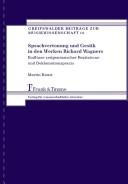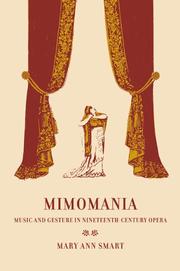| Listing 1 - 6 of 6 |
Sort by
|
Multi
ISBN: 9185974560 Year: 2000 Publisher: Göteborg : s.n.,
Abstract | Keywords | Export | Availability | Bookmark
 Loading...
Loading...Choose an application
- Reference Manager
- EndNote
- RefWorks (Direct export to RefWorks)
Acting in opera. --- Gesture in opera --- Performance practice (Music) --- -Performance practice (Music) --- Opera --- Gesture in opera. --- History --- -Acting in opera. --- Acting in opera
Book
ISBN: 9782343127149 234312714X Year: 2017 Publisher: Paris : L'Harmattan,
Abstract | Keywords | Export | Availability | Bookmark
 Loading...
Loading...Choose an application
- Reference Manager
- EndNote
- RefWorks (Direct export to RefWorks)
Issues d'un colloque tenu à Paris en 2016, ces contributions mettent en lumière la représentation et le rôle du geste dans de multiples disciplines artistiques : le théâtre d'Antonin Artaud, une sculpture de Rodin, les peintures de danseurs par Ye Qianyu, le bunraku, le flamenco, la chorégraphie de Liu Chan-Yueh, le cinéma japonais des années 1950 et le chef d'orchestre, entre autres.
Gesture --- Gesture in art --- Gesture in opera --- Gesture in dance --- Gesture in music --- Congresses --- Congresses.

ISBN: 9783865961143 Year: 2007 Publisher: Berlin : Frank & Timme,
Abstract | Keywords | Export | Availability | Bookmark
 Loading...
Loading...Choose an application
- Reference Manager
- EndNote
- RefWorks (Direct export to RefWorks)
Music and language. --- Gesture in opera. --- Music --- Philosophy and aesthetics --- Wagner, Richard, --- Wagner, Richard, --- Wagner, Richard, --- Criticism and interpretation. --- Dramaturgy.
Book
ISBN: 9782745325655 2745325655 Year: 2014 Volume: 143 Publisher: Paris: Champion,
Abstract | Keywords | Export | Availability | Bookmark
 Loading...
Loading...Choose an application
- Reference Manager
- EndNote
- RefWorks (Direct export to RefWorks)
Consacré à la production d'opéras italiens, chantés dans la langue originale, le Théâtre royal Italien est l'une des institutions artistiques les plus décisives du premier XIXe siècle. Mais ses chanteurs sont-ils aussi acteurs ? Que font, sur la scène des Italiens, des artistes aussi célèbres que Manuel García, Giuditta Pasta ou Maria Malibran ? Comment leurs publics décrivent-ils leurs pratiques scéniques et l'émotion qu'ils éprouvent à les regarder ? Voix et gestes enfuis, seules restent des impressions ou plutôt, des souvenirs d'impressions, tissées d'évidences pour les contemporains, perdues pour nous.Pour en retrouver la trace, sont croisés témoignages de spectateurs, sources littéraires, iconographiques et administratives souvent inédites. Car le talent de l'acteur-chanteur, quand il a quitté la scène, existe encore, et surtout, dans le souvenir de ceux qui l'ont vu. Cet ouvrage s'accompagne d'une chronologie des spectacles représentés au Théâtre-Italien de 1815 à 1848 ainsi que d'un dictionnaire de plus de 220 entrées répertoriant ses chanteurs.
Music --- Theatrical science --- anno 1800-1899 --- Paris --- Gesture in opera --- Acting in opera --- Operas --- Opera --- Singers --- Gestes à l'opéra --- Art de l'acteur à l'opéra --- Opéras --- Opéra --- Chanteurs --- Analysis, appreciation --- Stage-setting and scenery --- Job descriptions --- History --- Analyse et appréciation --- Décors --- Descriptions d'emploi --- Histoire --- Théâtre-Italien (Paris, France) --- Gestes à l'opéra --- Art de l'acteur à l'opéra --- Opéras --- Opéra --- Analyse et appréciation --- Décors --- Théâtre-Italien (Paris, France) --- Analysis, appreciation.
Book
ISBN: 2877500802 9782877500807 Year: 1997 Publisher: [S.l.] Zurfluh
Abstract | Keywords | Export | Availability | Bookmark
 Loading...
Loading...Choose an application
- Reference Manager
- EndNote
- RefWorks (Direct export to RefWorks)
Acting in opera --- Gesture in opera --- Opera --- Performance practice (Music) --- Art de l'acteur à l'opéra --- Gestes à l'opéra --- Opéra --- Pratique de l'exécution (Musique) --- Interpretation (Phrasing, dynamics, etc.) --- History --- Interprétation --- Histoire --- Art de l'acteur à l'opéra --- Gestes à l'opéra --- Opéra --- Pratique de l'exécution (Musique) --- Interprétation --- 78.41.2 --- Zang --- Methodes --- 18e eeuw --- 17e eeuw

ISBN: 1282358545 9786612358548 0520939875 1597347531 9780520939875 0520239954 9780520239951 9781597347532 1417545348 9781417545346 9780520248311 0520248317 9781282358546 6612358548 Year: 2004 Publisher: Berkeley, CA : University of California Press,
Abstract | Keywords | Export | Availability | Bookmark
 Loading...
Loading...Choose an application
- Reference Manager
- EndNote
- RefWorks (Direct export to RefWorks)
When Nietzsche dubbed Richard Wagner "the most enthusiastic mimomaniac" ever to exist, he was objecting to a hollowness he felt in the music, a crowding out of any true dramatic impulse by extravagant poses and constant nervous movements. Mary Ann Smart suspects that Nietzsche may have seen and heard more than he realized. In Mimomania she takes his accusation as an invitation to listen to Wagner's music-and that of several of his near-contemporaries-for the way it serves to intensify the visible and the enacted. As Smart demonstrates, this productive fusion of music and movement often arises when music forsakes the autonomy so prized by the Romantics to function mimetically, underlining the sighs of a Bellini heroine, for instance, or the authoritarian footsteps of a Verdi baritone. Mimomania tracks such effects through readings of operas by Auber, Bellini, Meyerbeer, Verdi, and Wagner. Listening for gestural music, we find resemblance in unexpected places: between the overwrought scenes of supplication in French melodrama of the 1820's and a cluster of late Verdi arias that end with the soprano falling to her knees, or between the mute heroine of Auber's La Muette de Portici and the solemn, almost theological pantomimic tableaux Wagner builds around characters such as Sieglinde or Kundry. Mimomania shows how attention to gesture suggests a new approach to the representation of gender in this repertoire, replacing aural analogies for voyeurism and objectification with a more specifically musical sense of how music can surround, propel, and animate the body on stage.
Gestes à l'opera. --- Opera --- Gesture in opera. --- Comic opera --- Lyric drama --- Opera, Comic --- Operas --- Drama --- Dramatic music --- Singspiel --- History and criticism --- 19th century. --- attention to gesture. --- auber. --- beauty. --- bellini. --- drama. --- famous composers. --- gestural music. --- live music. --- melodrama. --- meyerbeer. --- mimetic functions. --- mimomania. --- modern music. --- music and gesture. --- music criticism. --- music critics. --- music historians. --- music history. --- music studies. --- musical figures. --- musicians. --- musicology. --- nervous movements. --- nonfiction. --- opera composition. --- opera. --- pantomime. --- physical experiences. --- richard wagner. --- romantic period. --- verdi.
| Listing 1 - 6 of 6 |
Sort by
|

 Search
Search Feedback
Feedback About
About Help
Help News
News